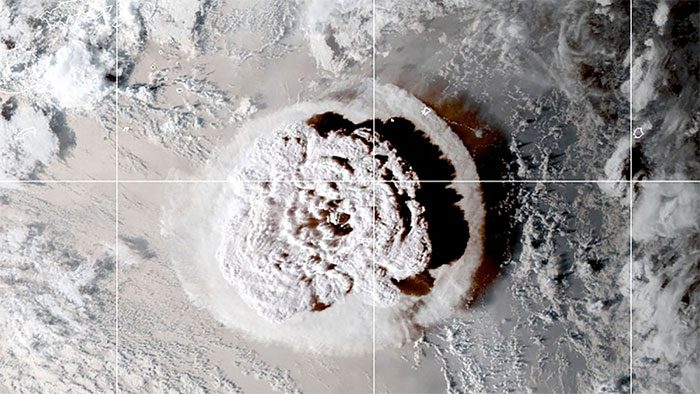The volcanic eruption in Tonga on January 15 has destroyed and submerged the volcano’s crater below sea level, rendering it invisible from satellite imagery.
The eruption has made it difficult for scientists to observe the volcano’s activity, Reuters reported on January 17.
The Hunga Tonga-Hunga Ha’apai volcano, located in the Pacific Ring of Fire, generated tsunami waves across the ocean and was audible from New Zealand, which is 2,300 kilometers away.

Satellite image of the Tonga volcano eruption on January 15.
“The concern right now is that we have very little information, and that is frightening. When the crater is underwater, we do not know what could happen,” said Janine Kripper, a volcanologist from New Zealand.
She added that on-site equipment may have been destroyed, and the scientific community is compiling the best available data to assess the explosion and predict future volcanic activity.
The Tonga eruption on January 15 was so powerful that satellites captured massive clouds of ash and shockwaves in the atmosphere traveling at nearly the speed of sound.
Images and videos show swirling ash clouds in the South Pacific and towering waves crashing onto the shores of Tonga.
Currently, there are no official reports of casualties or fatalities. Internet and phone services in Tonga are severely limited. Communication lines in many coastal areas have been cut off.
The loss of communication has also hindered outside agencies from reaching the Tonga Geological Services, which is monitoring the volcano.
The last eruption of this volcano occurred in 2014. Experts noted that the volcano had been simmering for a month before the lava surged to a temperature of 1,000 degrees Celsius, meeting seawater at 20 degrees, which caused a large and instantaneous explosion.
Scientists have stated that the speed and force of the explosion were “astonishing” and unusual compared to typical interactions between lava and water.
According to American meteorologist Chris Vagasky, the crater will continue to emit gas and other materials for several weeks or months.
“It would not be surprising if there are additional eruptions, although they may not be as large as the one on Saturday (January 15),” Mr. Vagasky said.
Many volcanologists have compared this eruption to the eruption of Mount Pinatubo in the Philippines in 1991, which was the second-largest volcanic eruption of the 20th century and resulted in approximately 800 deaths.



















































